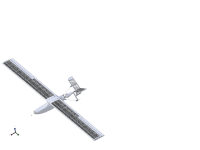The illustrated airplane tail surface combines articulation and side shift, providing adjustable, on-the-go variable longitudinal control for straight in-runway landings. There is no more correction from flight configuration to ground travel.
Pilots must exercise greater skill and caution in crosswind landings to transition from flight to a landing configuration. Imagine, however, if it were also possible to land the airplane on a true course straight down the runway regardless of crosswind by adjusting the control surfaces to compensate for the side shift of the aircraft.
Landing an airplane on a true course straight down the runway, regardless of crosswind, can be achieved by adjusting the control surfaces to compensate for the side shift of the aircraft.
The airplane’s tail section is attached to the airframe using a pinned (non-rotating along the axle axis) spherical joint. Actuators control the roll, pitch, and yaw angles, adjusting for the plane’s center of mass. The airplane’s direction is controlled by these actuators working together.
For those interested in more information, the design is explained in detail within US Patent 11,666,126 B2.
How is your idea novel or an improvement on what is currently available in the marketplace?
There have been similar mechanisms with two swashplates; however, they have yet to implement a fixed planar separation distance between them to provide a truly articulating and side-shifting mechanism. For various reasons, the distance between the two swashplates has been variable. The new mechanism would allow the vehicle more flexible maneuvering to position the tire to provide best clearance and traction.
The idea could be applied to airplanes with tires, floats, or skis when landing on a runway. Pilots of large and small airplanes would appreciate the ability to trim the controls and land the craft on a precise heading straight down the runway, even with a moderate crosswind.
Those who appreciate a safer, more straight-in heading while landing in crosswind conditions might be interested in this new development in these novel airplane controls.
How would your product be manufactured?
The product could use conventional casting, welding, and machining methods; additionally, some software controller logic would enhance the operation for the general user.
The number of components is relatively equivalent to the conventional airplane controls today. There would be a slight increase in the number of actuators required. The educational component for mechanics may, however, be steeper. There would need to be a paradigm shift to establish confidence in a different way that technicians are used to thinking about aircraft controls.
Prototype:
A prototype has been developed to validate the concept. An illustration of the prototype is also included in the reference US Patent. The prototype provides for the steer angles with four actuators. Regardless, one can identify that the variable roll, pitch, and yaw are all possible outcomes from these four actuators.
Video
Like this entry?
-
About the Entrant
- Name:Daniel Cowley
- Type of entry:individual
- Software used for this entry:Alibre Design Expert, DST SimWise Motion








